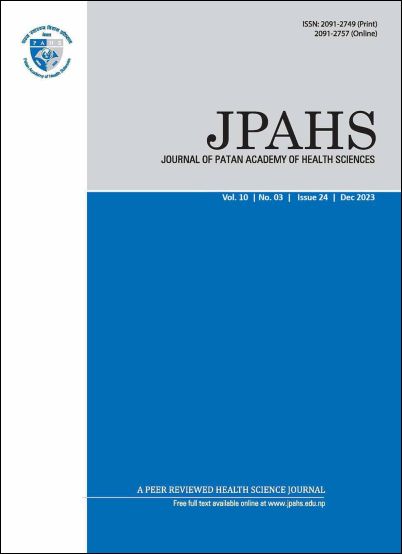Diabetic retinopathy in patients with newly diagnosed type 2 diabetes mellitus
DOI:
https://doi.org/10.3126/jpahs.v10i3.59177Keywords:
blindness, diabetes mellitus, diabetic retinopathy, NepalAbstract
Introduction: Diabetic retinopathy (DR) is the leading cause of visual impairment worldwide including Nepal and studies from populations have shown that up to 10% of diabetic patients have vision-threatening DR, with up to 5% requiring treatment at this initial visit. Within this context, this study aims to evaluate the presence of DR in newly diagnosed diabetic patients, presenting in the outpatient department of ophthalmology, at Patan Academy of Health Sciences.
Method: It is a retrospective cross-sectional study carried out in referred cases of newly diagnosed type 2 Diabetes Mellitus (DM) from January 2021 to December 2022. Information regarding age, gender, Body Mass Index (BMI), blood pressure (BP), Triglyceride (TG), proteinuria, and findings of fundus evaluation were extracted from the record maintained in the Department of Ophthalmology.
Result: Out of 102 patients with mean age of 49.1±13.6 y, 14(13.73%) had DR, 11(10.8%) had mild Non-proliferative Diabetic Retinopathy (NPDR) and three (2.9%) had moderate NPDR. There was female predominance 56(54.9%), 50(49%) patients were overweight or obese (BMI≥25 kg/m2), 15(14.7%) patients had proteinuria and 28(27.5%) had fasting hypertriglyceridemia and additional ocular anomaly was identified in 33(32.4%) patients.
Conclusion: Diabetic retinopathy is already present in significant proportion of newly diagnosed type 2 DM patients. Routine screening for DR at the time of diagnosis can improve ocular outcomes in newly diagnosed diabetics with targeted early treatment. Future research should evaluate this in wider population to generate guidelines for need of mandatory eye evaluation at diagnosis.
Downloads
Downloads
Published
How to Cite
Issue
Section
License
© Journal of Patan Academy of Health Sciences
Submission of the manuscript means that the authors agree to assign exclusive copyright to JPAHS. All authors must sign a Copyright Transfer and Author Agreement form upon submission of the manuscript to the Journal. The work shall not be published elsewhere in any language without the written consent of JPAHS. The articles published in this journal are protected by copyright which covers translation rights and the exclusive rights to reproduce and distribute all of the articles printed in the journal.




